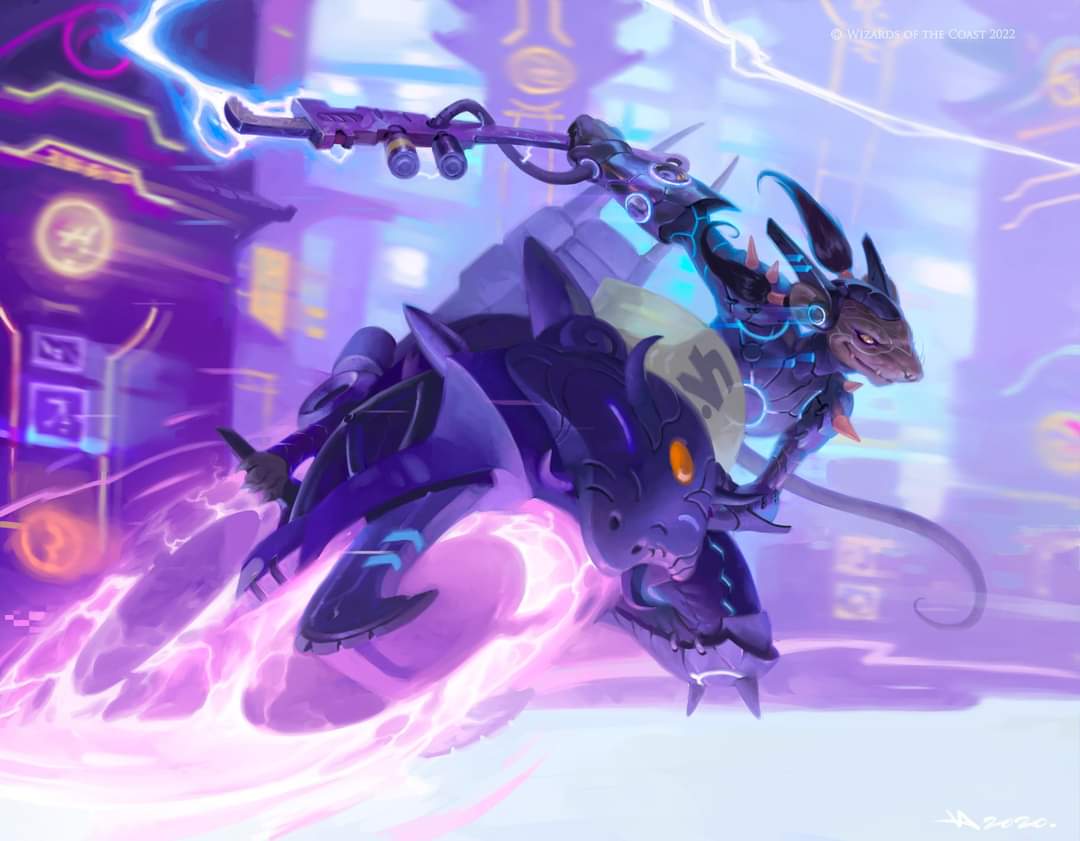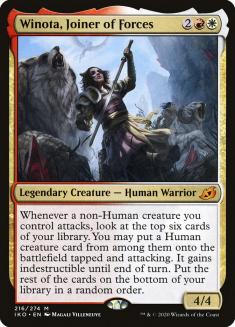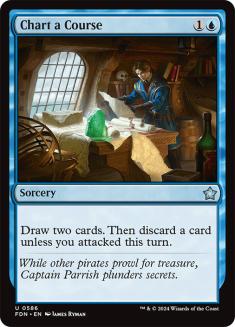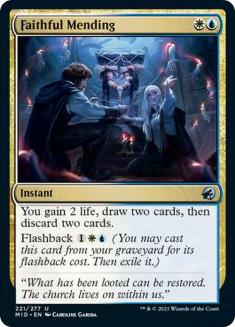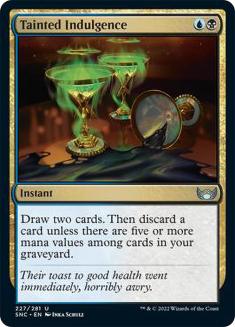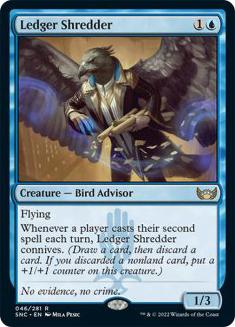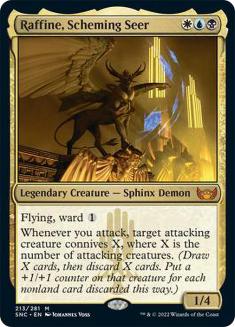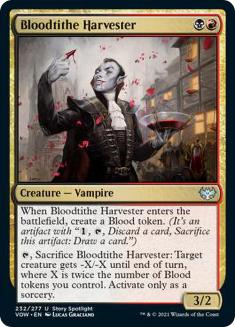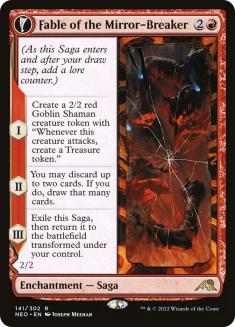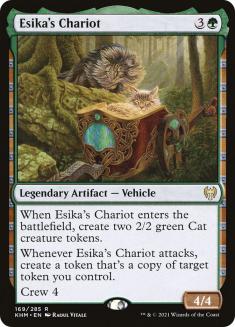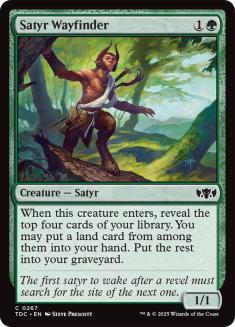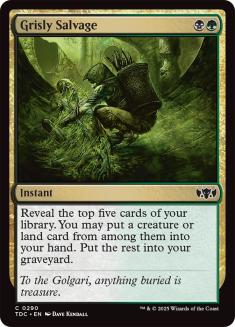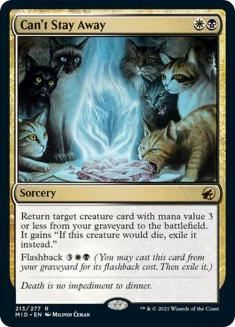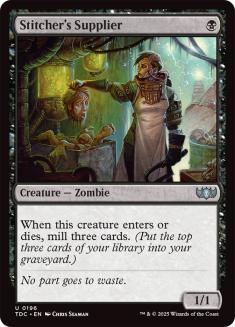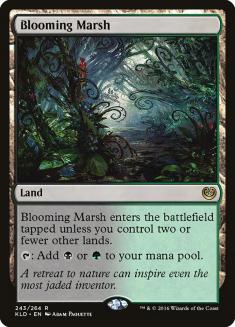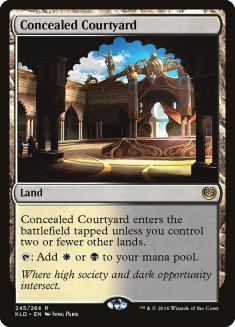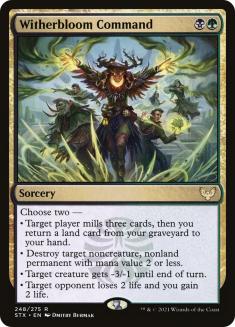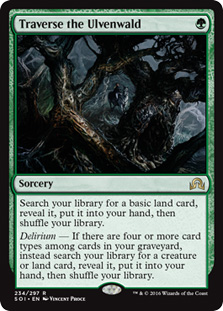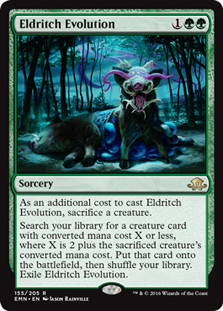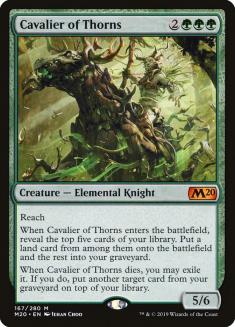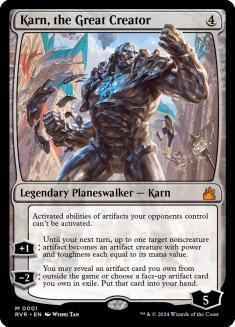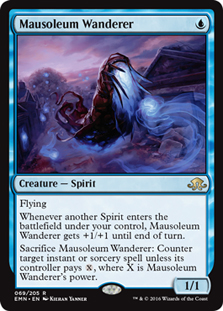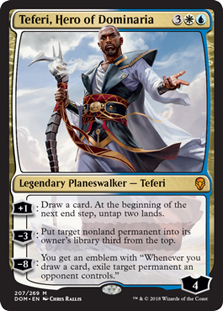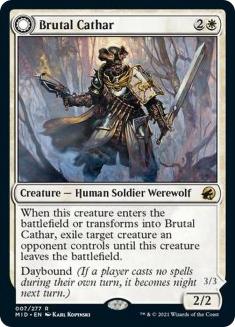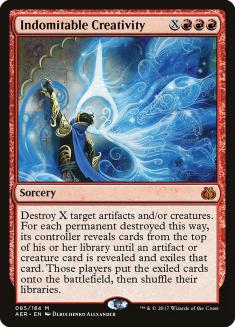Greasefang, Okiba Boss grabbed the attention of Pioneer players with the release of Kamigawa: Neon Dynasty but took some time to find its ideal home. It showed up in every conceivable colour combination but seemed to disappear just as quickly until the current wave of Abzan Greasefang decks found traction in the format. We’ll see why the other options fell out of favour, but the appeal of Greasefang is clear, especially given Pioneer’s recent history.
Winota’s Successor
Greasefang exploits the same play patterns and poor quality of interaction in Pioneer that made Winota, Joiner of Forces a ban-worthy menace. There simply isn’t much playable removal that can deal with even a moderately sized creature at instant speed. Greasefang is a little more vulnerable than Winota, as it falls in range of ‘mainstream’ removal like Fiery Impulse or Abrade, but even the format’s go-to ‘fair’ deck in Rakdos Midrange struggles to answer a Greasefang on the same turn because of the difficulty in reaching revolt for Fatal Push.
Compared to Winota, Greasefang’s damage output is capped but guaranteed. Parhelion II guarantees thirteen damage immediately and leaves the Angel tokens around to block and then attack again over the next turn cycle. The lesser Vehicles like Esika’s Chariot or Skysovereign, Consul Flagship can create an army or clean up the opponent’s respectively.
This synergy hasn’t made the jump to larger formats like Modern, not only because the interaction there is much better, but also because giving the opponent that one turn in between can spell doom in any number of ways. This can still happen in Pioneer – Azorius Control can sweep up your battlefield with Supreme Verdict or Farewell, and Mono-Green Devotion can combo off – but you feel much more confident in your position here.
Getting the Payoff
You have to work hard for this payoff. Like any Reanimator deck, you are essentially trying to assemble a three-card combo: your reanimation effect, your reanimation target, and a way to get that target in the graveyard. Greasefang is a unique effect with no understudy; you need Greasefang specifically. There are few Vehicles worth reanimating with Greasefang, so that component has limitations too.
The real question is how you stitch that together. Each colour combination offers different ways to find these cards and put them in their place, as well as its own supporting cast.
Blue for Esper
Blue is the best in the business for looting effects, with more strong candidates than you could possibly play. You can’t spend too much time just sifting through cards, but permanents like Jace, Vryn’s Prodigy or Tezzeret, Betrayer of Flesh let you accomplish something on the battlefield while funneling cards between zones.
Streets of New Capenna offered a bounty of riches for Esper Greasefang – another strong instant-speed discard outlet in Tainted Indulgence as well as an air force that supports your main plan while acting as a powerful alternative in the face of graveyard hate. Someone who keeps an otherwise unexciting hand on the back of Unlicensed Hearse can be easily bamboozled by Raffine, Scheming Seer or the set’s main success story in Ledger Shredder.
Why Not Blue
This all sounds very promising. So why is Esper not the default colour combination? In practice, each element is still somewhat inconsistent. You have more ways to deposit Parhelion II in your graveyard than any other approach, but you still need to find at least the first copy of Greasefang for this to mean anything, leaving the same inherent weakness of any two-card combo.
Meanwhile, Ledger Shredder is unexciting in a format without Modern’s density of cheap (or free!) spells. There’s a good reason that you only really see it in the various Izzet decks in Pioneer, and even some of those are moving away from it. It’s hard to find room for the two-mana filtering in Esper as well as the Considers and Thoughtseizes or Fatal Pushes you need to power Shredder, forcing some tough choices. Raffine’s Informant into Raffine, Scheming Seer is a proactive start, but not a scary one compared to what other decks are capable of. The flexibility these plans offer is a double-edged sword. It’s easy to end up as a mediocre combo deck with a lazy midrange deck as an awkward roommate.
I wouldn’t write Esper off altogether, but it’s not the natural home for Greasefang that it appears to be at a glance.
Red for Mardu
Mardu Greasefang tore up the early Explorer events, and it’s easy to see the appeal. Bloodtithe Harvester and Fable of the Mirror-Breaker are cornerstones of the Rakdos Midrange deck that defines the format, and Mardu Greasefang gets additional value from these cards as discard outlets.
If Esper Greasefang is a combo deck that can masquerade as a midrange deck, Mardu Greasefang is a midrange deck with this homemade Splinter Twin spliced in. Rakdos Midrange is a proven template to work from, but this prompts an obvious question: why mess with success by adding these conditional cards and a whole third colour to a deck that doesn’t need the help?
That brings us to Abzan. Jan-Moritz Merkel put this variant on the map in a big way on Magic Online (MTGO), and some of us mere mortals were able to replicate his success.
You Can Drive My Car
The biggest draw to green is a brand-new car. It’s not inconceivable to play Esika’s Chariot as an off-colour Vehicle in other lists or get ambitious with some Mech Hangar manabase, but Abzan gets to take it for granted and cast it consistently. Greasefang returning and attacking with Chariot isn’t guaranteed to take over the game the way Parhelion II is, especially as the game goes long, but having another powerful Vehicle makes it much easier to cast Greasefang and immediately attack with something on Turn 3. In matchups where Greasefang is unlikely to survive, you can shave copies of the mostly uncastable Parhelion II and still have a decent quantity of Vehicles thanks to Chariot.
As in Naya Winota, Chariot is also the perfect backup plan. Most of the limited range of removal that hits Greasefang at instant-speed either doesn’t hit Chariot at all or only deals with some fraction of it. An opponent who is delaying their development to hold up interaction for Greasefang can be caught off-guard by Chariot and the cat car is threatening enough that it may demand that removal itself if possible. When you do have to get scrappy, it’s much easier to seal the deal with a single Chariot backed up by interaction than with a solo Shredder or Raffine.
Self-Millionaire
Green leans heavily on self-mill effects to fill its graveyard for Greasefang. Grisly Salvage is the best, finding that crucial namesake while potentially binning a Vehicle. These cards churn through more of your deck than Faithful Mending or Tainted Indulgence, but are narrower in function.
Oddly, this makes your Vehicles more ‘accessible’ from your library than from your hand. Abzan Greasefang is light on discard outlets and will often have a Parhelion stuck in the wrong zone. Greasefang players of all stripes wanted to try Liliana of the Veil when it was reprinted in Dominaria United, but for the Abzan contingent, the +1 ability as a discard outlet was the biggest draw.
This increases the importance of Can’t Stay Away, a nice way to force Greasefang through removal in any list, but more necessary in Abzan. It’s common to turn over a Greasefang with Satyr Wayfinder and need a way to bring it back, with Wayfinder helping you build towards the five mana to flashback Can’t Stay Away if necessary.
Abzan Greasefang has great interest in Stitcher’s Supplier thanks to its interactions with Grisly Salvage and Can’t Stay Away, including the elusive nut draw of Turn 1 Stitcher’s Supplier setting up Turn 2 Can’t Stay Away on Greasefang. It’s also dangerous and annoying for anyone trying to attack on the ground, as the additional mill trigger when it dies can suddenly unlock a Greasefang turn for you.
Supplier is excellent at pushing your main plan but poor in the face of graveyard hate. When building your sideboard, you want to be able to cut down on these depending on the kind of resistance you expect.
Step 1: Add Lands
These self-mill cards all find lands, making it tempting to shave cards that are ‘just’ lands and fit more relevant spells into your deck. It’s easy to take this too far, though. You don’t want to be forced to take a land off Grisly Salvage to keep casting spells if there are more appealing options, but it does change your deckbuilding incentives relative to these other approaches.
When you have fewer lands, you need those lands to work smoothly. Pioneer contains the Kaladesh fastlands but not the original Scars of Mirrodin set, meaning that access to this cycle is unevenly distributed between colour combinations. Abzan can boast that Blooming Marsh and Concealed Courtyard both add black, your most important colour overall and the one you need earliest for Turn 1 Thoughtseize or Fatal Push.
Your Wish Is My Command
Witherbloom Command is an all-star in this archetype and a key to its success in my view. It’s a good hedge against permanent graveyard hate in post-sideboard games, as it also furthers your main plan at the same time (or in the absence of anything to remove), but it’s not uncommon to see maindeck Unlicensed Hearse in decks like Rakdos Midrange, and this is an essential answer there. It’s also the best way to break serve against Mono-Green Devotion by tagging Llanowar Elves or Wolfwillow Haven and hopefully milling a missing piece.
Against the format at large, Mono-White Humans is just one of several decks full of one-toughness creatures where a well-timed removal spell can swing the race in your favour. You can expect to sideboard out Witherbloom Command sometimes (in contrast to enablers like Wayfinder or Salvage that never leave the deck), but when it’s good, it’s phenomenal.
Where’s Ulvenwaldo?
Green has some direct tutors for Greasefang if you’re willing to jump through some deckbuilding hoops first. Traverse the Ulvenwald is cheap enough to let you find and cast Greasefang in the same turn once you have delirium, and you will sometimes want your copy of Boseiju, Who Endures (or just a basic land when you don’t have future land drops lined up and delirium is a pipe dream). The upside on Traverse is very appealing, but it doubles down on your weakness to the graveyard hate that is already a problem for the deck.
The Green Evolution
Eldritch Evolution is a more difficult puzzle and another throwback to the early Winota days. Before that deck could play a reliable midrange game with Fable of the Mirror-Breaker and Esika’s Chariot, it had to lean into its combo draws, and turning Voice of Resurgence or similar into Winota was the best way to do that. Abzan Greasefang already has some interest in creatures that you’re glad to sacrifice, from Stitcher’s Supplier to Satyr Wayfinder, and once you decide to believe in Evolution, you can turn to other discard outlets attached to creatures.
You can expect to find Greasefang the vast majority of the time, but what about those edge cases? A Knight of Autumn in the sideboard as a searchable answer to hate cards makes sense, and it’s easy to talk yourself into some alternate threat ( Rotting Regisaur? Sheoldred, the Apocalypse?), but there’s always the risk of diluting your deck with cards that don’t help your main plan but aren’t actually good enough as a backup plan, especially if you’re spending three mana and two cards to find them. Adding a singleton to your deck for Evolution also carries some risk when you are intentionally milling so much of your deck. An unlucky Satyr Wayfinder may remove that option from a later Evolution or Traverse altogether.
After you make these decisions, you have to turn your sights to the format at large.
Defeating Mono-Green Devotion
Mono-Green Devotion is an important litmus test for any Pioneer deck, and one Greasefang seemingly should fail. Karn, the Great Creator takes over the game just by sitting there as the static ability stops you crewing Vehicles, and it can find Tormod’s Crypt, Pithing Needle, or other problematic artifacts to keep the squeeze on even if Karn dies. Cavalier of Thorns can block Parhelion II or its tokens to cut your clock in half, and Mono-Green has a clear run at its own combo, as Greasefang can barely interact.
On the other hand, your best draws can flood the battlefield with tokens quickly, and even a follow-up Karn is dead on arrival at that point. Witherbloom Command can put you ahead in the race to your critical turn or cripple a draw that relies on its Elf or Wolfwillow Haven, while Thoughtseize gives you a way to strip the Karn (or Cavalier, or whatever one card lets their hand go off). Overall I don’t think the matchup is actually that bad. As with so many matchups in Pioneer and so many matchups that involve Mono-Green, I’d put my money on whoever’s on the play.
Defeating Rakdos Midrange
Rakdos Midrange is another pillar of Pioneer that should be tough on paper, with discard, removal, and a relatively fast clock including maindeckable graveyard hate in the form of Graveyard Trespasser. In practice, you have more virtual copies of Greasefang than they have Thoughtseizes, and the much-touted weakness of Rakdos’s removal makes itself known here. Dreadbore is too little, too late, and Fatal Push has to become a two-card combo with Bloodtithe Harvester to even operate at instant speed. Graveyard Trespasser is sorcery-speed graveyard hate, which can limit its effectiveness, and Trespasser is increasingly seen as the most expendable of the deck’s many three-drops.
It’s not a free matchup – and it becomes actively difficult if opponents show up with dedicated hate like Leyline of the Void – but it’s a fine one, and the reasons why help to demonstrate why Greasefang is able to flourish in the format.
There are a lot of possible enemies in Pioneer and there’s a level of comfort in being a consistent, proactive deck that can steal games with good draws even in bad matchups and has access to black’s best disruption. The other side of that coin is that anybody who really wants to beat you probably can – but, until that happens, pledging your loyalty to the Okiba Boss is a wise move.

